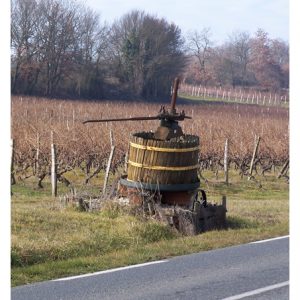Distilling Cognac on the Lees
 We have often talked about distillation on the Lees but rarely described why we do it or indeed what ‘the lees’ are.
We have often talked about distillation on the Lees but rarely described why we do it or indeed what ‘the lees’ are.
Many years ago, during cognac production, whole bunches of grapes were crushed in presses to release the grape juice. The process was fairly crude and some stalks, pips and skins found their way into the juice. This negatively affected the flavour of the wine and sometimes even contaminated it. Grape crushing was therefore banned after the turn of the twentieth century.
The newly designed horizontal presses had slats on the sides. These rotated slowly putting very little pressure on the grapes, so only the juice escaped. Modern rotating presses also have hydraulic plates at either end. These plates exert slightly more pressure on the grapes which extracts the maximum amount of juice and some of the pulp (but not the skin, stalks or pips). This combination of juice and pulp is known as ‘the lees’. It is the pulp which provides more of the grape flavours. A wine producer might refer to it as the second pressing.
Most cognac producers will use ‘the lees’ in their distillation as it adds to the quantity produced as well as the flavour. Not all distillers will admit to it though. There is a fear that some buyers believe cognacs distilled not on their lees will be purer, albeit with less flavour. There is also a problem if the producers sell to the big houses as they ask distillers not to use the lees. The big houses require cognacs with greater neutrality for blending with many others from different distillers. Extremes of flavour will affect the uniformity of products which are sold in vast quantities.
Whatever the case for or against this process, those seeking greater individuality of flavours should always look for cognacs that were distilled on their ‘lees’. The Hermitage range is a classic example.
